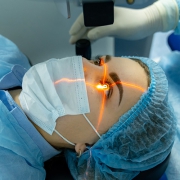The Risks of LASIK Surgery: Separating Facts from Myths
LASIK surgery is a popular procedure that has helped millions of people achieve better vision without the need for glasses or contact lenses. While LASIK is generally safe and effective, there are risks associated with the procedure that patients should be aware of. In this post, we will separate the facts from the myths surrounding LASIK surgery.
Myth: LASIK is completely safe and has no risks
FACT: While LASIK is a safe and effective procedure, like any surgery, it does have risks. The most common side effects of LASIK include dry eyes, halos, glare, and difficulty seeing at night. These side effects are usually temporary and can be treated with eye drops or other medications. However, more serious complications, such as infection, vision loss, or corneal ectasia (thinning of the cornea), can occur, though they are rare.
Myth: LASIK is painful
FACT: Most patients report feeling some pressure or discomfort during the LASIK procedure, but it is not typically described as painful. Before the procedure, patients are given numbing eye drops to minimize any discomfort. After the procedure, patients may experience some mild discomfort or itching, but this can be treated with over-the-counter pain relievers.
Myth: LASIK is a quick fix for vision problems
FACT: While LASIK can provide significant improvement in vision, it is not a guaranteed solution for all vision problems. Patients with severe nearsightedness, farsightedness, or astigmatism may still require glasses or contact lenses after the procedure. Additionally, some patients may require additional procedures or enhancements to achieve their desired level of vision correction.
Myth: Anyone can undergo LASIK surgery
FACT: Not everyone is a good candidate for LASIK surgery. Candidates must have stable vision, be over the age of 18, and have a prescription that falls within certain parameters. Patients with certain medical conditions, such as autoimmune diseases, uncontrolled diabetes, or pregnancy, may not be good candidates for LASIK. Additionally, patients with thin or irregular corneas may not be eligible for the procedure.
Myth: LASIK is a one-time procedure
FACT: While LASIK is a one-time procedure, the effects of aging and other factors can cause changes to the eyes over time. Some patients may require additional procedures or enhancements to maintain their vision correction. Additionally, as with any surgery, there is a risk of complications, which may require further treatment.
In Conclusion
LASIK surgery can be a safe and effective option for vision correction, but it is not without risks. Patients should be aware of the potential side effects and complications associated with the procedure, and should carefully consider whether LASIK is the right choice for them. It is important to consult with an experienced ophthalmologist to determine if LASIK is a good option for your individual needs and circumstances.









